Related Research Articles

Shravanabelagola is a town located near Channarayapatna of Hassan district in the Indian state of Karnataka and is 144 km (89 mi) from Bengaluru. The Gommateshwara Bahubali statue at Shravanabelagola is one of the most important tirthas in Jainism, one that reached a peak in architectural and sculptural activity under the patronage of Western Ganga dynasty of Talakad. Chandragupta Maurya is said to have died on the hill of Chandragiri, which is located in Shravanabelagola, in 298 BCE after he became a Jain monk and assumed an ascetic life style.
This article concerns the period 879 BC – 870 BC.

In Jainism, a Tirthankara is a saviour and supreme spiritual teacher of the dharma. The word tirthankara signifies the founder of a tirtha, a fordable passage across saṃsāra, the sea of interminable birth and death. According to Jains, tirthankaras are the supreme preachers of dharma, who have conquered saṃsāra on their own and made a path for others to follow. After understanding the true nature of the self or soul, the Tīrthaṅkara attains kevala jnana (omniscience). A Tirthankara provides a bridge for others to follow them from saṃsāra to moksha (liberation).

The Mahamastakabhisheka refers to the abhiṣeka (anointment) of the Jain idols when held on a large scale. The most famous of such consecrations is the anointment of the Bahubali Gommateshwara statue located at Shravanabelagola in Karnataka, India. It is an important Jain festival held once every 12 years. It is an integral part of the ancient and composite Jain tradition.

Buddhism and Jainism are two Indian religions that developed in Magadha (Bihar) and continue to thrive in the modern age. Gautama Buddha and Mahavira are generally accepted as contemporaries. Jainism and Buddhism share many features, terminology and ethical principles, but emphasize them differently. Both are śramaṇa ascetic traditions that believe it is possible to attain liberation from the cycle of rebirths and deaths (samsara) through spiritual and ethical disciplines. They differ in some core doctrines such as those on asceticism, Middle Way versus Anekantavada, and self versus non-self.

Ācārya Bhadrabāhu was, according to both the Śvetāmbara and Digambara sects of Jainism, the last Shruta Kevalin in Jainism.
In Jainism, godliness is said to be the inherent quality of every soul. This quality, however, is subdued by the soul's association with karmic matter. All souls who have achieved the natural state of infinite bliss, infinite knowledge, infinite power and infinite perception are regarded as God in Jainism. Jainism rejects the idea of a creator deity responsible for the manifestation, creation, or maintenance of this universe. Instead, souls who have reached Heaven for their merits and deeds influence the Universe for a fixed period until they undergo reincarnation and continue the cycle of enlightenment. According to Jain doctrine, the universe and its constituents have always existed. All constituents and actions are governed by universal natural laws and "perfect soul".
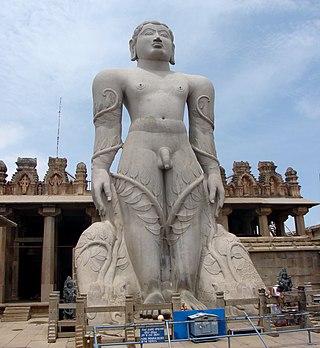
Bahubali was the son of Rishabhanatha and the brother of the chakravartin Bharata. He is a revered figure in Jainism. He is said to have meditated motionless for 12 years in a standing posture (kayotsarga), with climbing plants having grown around his legs. After his 12 years of meditation, he is said to have attained omniscience.

Nemichandra, also known by his epithet Siddhanta Chakravarty, was a Jain acharya from present-day India. He wrote several works including Dravyasamgraha, Gommatsāra, Trilokasara, Labdhisara and Kshapanasara.

Digambar Jain Mahasabha or Shri Bharatvarshiya Digamber Jain Mahasabha is the oldest organisation of lay 20 panthi sarabati Jains in India.

Jainism in North Karnataka flourished under the Chalukyas, Kadamba, Rashtrakutas, and Vijayanagara Empire. Imbued with religious feeling, patronage was extended towards the building of Jain temple and it garnered high repute among the people, particularly the ruling classes and the mercantile community; effectively getting treated as the state religion.
Jai Jinendra! is a common greeting used by the Jains. The phrase means "Honor to the Supreme Jinas (Tirthankaras)"
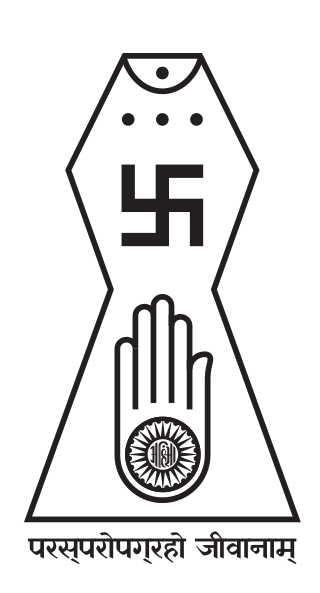
Parasparopagraho Jīvānām is a Jain aphorism from the Tattvārtha Sūtra [5.21]. It is translated as "Souls render service to one another". It is also translated as, "All life is bound together by mutual support and interdependence." These translations are virtually the same, because Jains believe that every living being, from a plant or a bacterium to human, has a soul and the concept forms the very basis of Jainism.

Arihant is a jiva (soul) who has conquered inner passions such as attachment, anger, pride and greed. Having destroyed four inimical karmas, they realize pure self. Arihants are also called kevalins as they possess kevala jnana. An arihant is also called a jina ("victor"). At the end of their life, arihants destroy remaining karmas and attain moksha (liberation) and become siddhas. Arihantas have a body while siddhas are bodiless pure spirit. The Ṇamōkāra mantra, the fundamental prayer dedicated to Pañca-Parameṣṭhi, begins with Ṇamō arihantāṇaṁ, "obeisance to the arihants".

Jina Kanchi Jain Math, Melsithamur, is a Jain Matha that is located near Gingee, Villupuram district, Tamil Nadu, India.
Jainism and Hinduism are two ancient Indian religions. There are some similarities and differences between the two religions. Temples, gods, rituals, fasts and other religious components of Jainism are different from those of Hinduism.
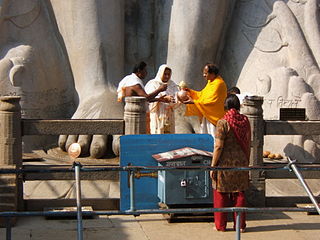
In Jainism, the word Śrāvaka or Sāvaga is used to refer to the Jain laity (householders). The word śrāvaka has its roots in the word śrāvana, i.e. the one who listens.
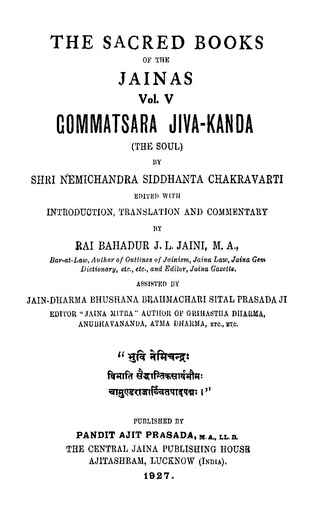
Gommatsāra is one of the most important Jain texts authored by Acharya Nemichandra Siddhanta Chakravarti.
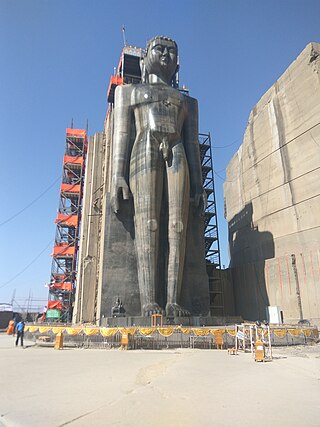
The Statue of Ahimsa is located at Mangi-Tungi, in Nashik, in the Indian state of Maharashtra. It is the tallest Jain statue in the world. The statue depicts the first Jain Tirthankara, Rishabhanatha. The statue is 108 feet (33 m) tall – 121 feet (37 m) including pedestal. The statue has been carved out of the Mangi-Tungi hills, which are considered to be sacred by the Jains.
Vilas Adinath Sangave was an Indian sociologist and Jainologist. He was born to a Marathi Jain family in Solapur, Maharashtra. Sangave died at the age of 90.
References
- Sangave, Vilas Adinath (2001), Facets of Jainology: Selected Research Papers on Jain Society, Religion, and Culture, Mumbai: Popular Prakashan, ISBN 978-81-7154-839-2